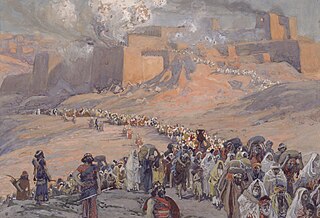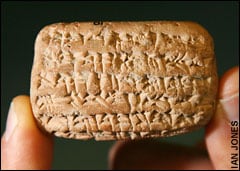 W
WThe Al-Yahudu tablets are a collection of about 200 clay tablets from the sixth and fifth centuries BCE on the exiled Judean community in Babylonia following the destruction of the First Temple. They contain information on the physical condition of the exiles from Judah and their financial condition in Babylon. The tablets are named after the central settlement mentioned in the documents, al-Yahudu.
 W
WThe Babylonian captivity or Babylonian exile is the period in Jewish history during which a number of people from the ancient Kingdom of Judah were captives in Babylon, the capital of the Neo-Babylonian Empire. The event is described in the Hebrew Bible and its historicity is supported by archaeological and non-biblical evidence.
 W
WBabylonian Jewry Heritage Center is a museum and research center in Or Yehuda, Israel.
 W
WBelshazzar's feast, or the story of the writing on the wall, tells how Belshazzar holds a great feast and drinks from the vessels that had been looted in the destruction of the First Temple. A hand appears and writes on the wall. The terrified Belshazzar calls for his wise men, but they are unable to read the writing. The queen advises him to send for Daniel, renowned for his wisdom. Daniel reminds Belshazzar that his father Nebuchadnezzar, when he became arrogant, was thrown down until he learned that God has sovereignty over the kingdom of men. Belshazzar had likewise blasphemed God, and so God sent this hand. Daniel then reads the message and interprets it: God has numbered Belshazzar's days, he has been weighed and found wanting, and his kingdom will be given to the Medes and the Persians.That very night Belshazzar the Chaldean (Babylonian) king was killed, and Darius the Mede received the kingdom.
 W
WDarius the Mede is mentioned in the Book of Daniel as king of Babylon between Belshazzar and Cyrus the Great, but he is not known to history, and no additional king can be placed between the known figures of Belshazzar and Cyrus. Most scholars view him as a literary fiction, but some have tried to harmonise the Book of Daniel with history by identifying him with various known figures, notably Cyrus or Gobryas, the general who was first to enter Babylon when it fell to the Persians in 539 BCE.
 W
WThe Exilarch was the leader of the Jewish community in Persian Mesopotamia during the era of the Parthians, Sassanids and Abbasid Caliphate up until the Mongol invasion of Baghdad in 1258, with intermittent gaps due to ongoing political developments. The Exilarch was universally regarded by the Jewish community as the royal heir of the House of David and held a place of prominence as both a rabbinical authority and as a noble within the Persian court. Within the Sassanid Empire, the Exilarch was the political equivalent of the Catholicos of the Christian Church of the East, and was thus responsible for community-specific organizational tasks such as running the rabbinical courts, collecting taxes from Jewish communities, supervising and providing financing for the Talmudic Academies in Babylonia, and the charitable re-distribution and financial assistance to needy members of the exile community. The position of Exilarch was hereditary, held in continuity by a family that traced its patrilineal descent from antiquity stemming from king David.
 W
WThe Fall of Babylon denotes the end of the Neo-Babylonian Empire after it was conquered by the Achaemenid Empire in 539 BCE. Historians also use the term Liberation of Babylonia interchangeably.
 W
WIggeret of Rabbi Sherira Gaon, also known as the Letter of Rav Sherira Gaon, and the Epistle of Rav Sherira Gaon, is a responsum penned in the late 10th century in the Pumbedita Academy by Sherira Gaon, the Chief Rabbi and scholar of Babylonian Jewry, to Rabbi Jacob ben Nissim of Kairouan, in which he methodologically details the development of rabbinic literature, bringing down a chronological list of the Sages of Israel from the time of the compilation of the Mishnah, to the subsequent rabbinic works, spanning the period of the Tannaim, Amoraim, Savoraim, and Geonim under the Babylonian Exilarchs, concluding with his own time. Therein, Sherira Gaon outlines the development of the Talmud, how it was used, its hermeneutic principles, and how its lessons are to be applied in daily life whenever one rabbinic source contradicts another rabbinic source. It is considered one of the classics in Jewish historiography.
 W
WAl-Mada'in was an ancient metropolis on the Tigris River which lay between the ancient royal centers of Ctesiphon and Seleucia. It was founded during Sasanian rule, and was used as a synonym for Ctesiphon by the Arabs, and later by the Muslims.
 W
WNebo-Sarsekim Tablet is a clay cuneiform inscription referring to an official at the court of Nebuchadnezzar II, king of Babylon. It may also refer to an official named in the Biblical Book of Jeremiah.
 W
WNehardea or Nehardeah was a city from the area called by ancient Jewish sources Babylonia, situated at or near the junction of the Euphrates with the Nahr Malka, one of the earliest centers of Babylonian Judaism. As the seat of the exilarch it traced its origin back to King Jehoiachin. According to Sherira Gaon, Jehoiachin and his coexilarchs built a synagogue at Nehardea, for the foundation of which they used earth and stones which they had brought, in accordance with the words of Psalms 102:15, from Jerusalem. For this reason it was called 'The Synagogue that Slid and Settled'. This was the synagogue called "Shaf we-Yatib," to which there are several references dating from the third and fourth centuries was the seat of the Shekhinah in Babylonia. The Aaronic portion of the Jewish population of Nehardea was said to be descended from the slaves of Pashur ben Immer, the contemporary of King Jehoiachin.
 W
WNehardea Academy was one of the major rabbinical academies in Babylon, active intermittently from the early Amoraim period and until the end of the Geonim period. It was established by the Amora Samuel of Nehardea, one of the great sages of Babylon.
 W
WPumbedita, literally meaning in Aramaic: "The Mouth of the River," was the name of a city from the area called by ancient Jewish sources Babylonia, close to the modern-day city of Fallujah, in Anbar Province, Iraq.
 W
WPumbedita Academy or Pumbedita Yeshiva was a yeshiva in Babylon during the era of the Amoraim and Geonim sages. It was founded by Judah bar Ezekiel and, with the Sura Academy founded in 225 by Abba Arika, was an influential and dominant yeshiva for about 800 years.
 W
WSura was a city in the southern part of the area called by ancient Jewish sources Babylonia, located east of the Euphrates. It was well-known for its agricultural produce, which included grapes, wheat, and barley. It was also a major center of Torah scholarship and home of an important yeshiva - the Sura Academy - which, together with the yeshivas in Pumbedita and Nehardea, gave rise to the Babylonian Talmud.
 W
WSura Academy was a Jewish yeshiva located in Sura, Babylonia. With Pumbedita Academy, it was one of the two major Jewish academies from the year 225 CE at the beginning of the era of the Amora sages until 1033 CE at the end of the era of the Gaonim. Sura Yeshiva Academy was founded by the Amora Abba Arika ("Rav"), a disciple of Judah ha-Nasi. Among the well-known sages that headed the yeshiva were Rav Huna, Rav Chisda, Rav Ashi, Yehudai Gaon, Natronai Gaon, Saadia Gaon, and others.
 W
WThe Talmudic academies in Babylonia, also known as the Geonic academies, were the center for Jewish scholarship and the development of Halakha from roughly 589 to 1038 CE in what is called "Babylonia" in Jewish sources, at the time otherwise known as Asōristān or Iraq. It is neither geopolitically, nor geographically identical with the ancient empires of Babylonia, since the Jewish focus of interest has to do with the Jewish religious academies, which were mainly situated in an area between the rivers Tigris and Euphrates and primarily between Pumbedita, and Sura, a town farther south down the Euphrates.